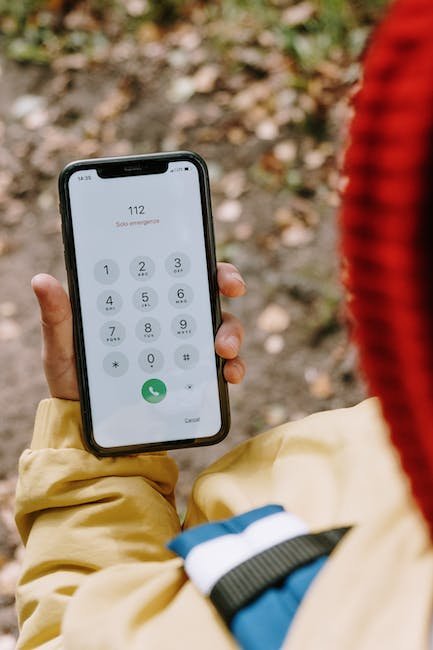Now Reading: Best Emergency Distress Signals: A Comprehensive Guide
-
01
Best Emergency Distress Signals: A Comprehensive Guide

Best Emergency Distress Signals: A Comprehensive Guide
When words fail and danger lurks, our primal instincts kick in, urging us to seek help in the most desperate of situations. In those critical moments, when all seems lost, a distress signal can become the lifeline that connects us with the assistance we so desperately need. Varying from blaring sounds to humble yet powerful gestures, emergency distress signals have evolved into an array of ingenious methods designed to catch the attention of potential rescuers. In this comprehensive guide, we delve into the world of emergency distress signals, uncovering the most effective techniques that can make all the difference between survival and peril. Whether you find yourself lost at sea or stranded in a vast wilderness, join us as we explore the best emergency distress signals that can challenge fate and summon aid when it matters most.
Table of Contents
- Important Factors to Consider for Emergency Distress Signals
- Understanding Different Types of Emergency Distress Signals
- Expert Recommendations for Emergency Distress Signals
- Choosing the Right Emergency Distress Signal for Your Situation
- Key Tips for Effectively Using Emergency Distress Signals
- Q&A
- To Wrap It Up

Important Factors to Consider for Emergency Distress Signals
In emergency situations, being able to effectively communicate distress signals can be a matter of life and death. Whether you’re stranded at sea, lost in the wilderness, or trapped in a collapsed building, knowing how to send distress signals is crucial. Here are some important factors to consider:
- Visibility: The main purpose of an emergency distress signal is to attract attention. Therefore, it is essential to choose signals that are highly visible. This can include using bright-colored clothing, reflective materials, or signaling devices such as flares or strobe lights.
- Uniqueness: To ensure your distress signals are easily distinguishable from other signals in the area, it is important to choose signals that are unique. This can involve using specific patterns of sounds, sequences of flashes, or distinct hand gestures.
- Standardization: When communicating distress signals, it is crucial to use standardized signals recognized internationally. For example, Morse code has been widely adopted as a standardized means of communication in emergency situations. Therefore, it is important to familiarize yourself with these standardized signals to ensure proper communication and understanding when in distress.
- Consistency: Consistency is key when sending distress signals. It is important to repeat your signals consistently and at regular intervals to increase the chances of being noticed by potential rescuers. This can help differentiate your signals from background noise and ensure that they are recognized as distress signals.
Remember, distress signals are an integral part of survival in emergency situations. By considering factors such as visibility, uniqueness, standardization, and consistency, you can maximize your chances of attracting attention and receiving the necessary help. Practice and familiarize yourself with different distress signals so that when the time comes, you are confident and prepared to communicate effectively.

Understanding Different Types of Emergency Distress Signals
In situations where communication infrastructure may be compromised or unavailable, knowing how to effectively communicate distress signals can save lives. Emergency distress signals are crucial in catching attention and alerting potential rescuers or passersby about a critical situation. Here, we explore several types of emergency distress signals that can be used in various situations:
1. Visual Distress Signals:
Visual signals are highly effective during daylight hours or when visibility is good. These signals can be easily spotted from a distance. Some examples include:
- Raising an arm or leg repeatedly.
- Shining a flashlight or mirror towards the sky.
- Creating a fire or smoke signal.
2. Auditory Distress Signals:
Auditory signals are useful when visibility is limited or at night. These signals rely on sound to convey distress. Here are a few examples:
- Blowing a whistle in a distinctive pattern or short bursts.
- Sounding a horn, bell, or a rhythmic tapping sound.
- Shouting or using a megaphone to call for help.
3. Electronic Distress Signals:
In today’s modern world, electronic devices play a significant role in emergency situations. These signals require battery-operated equipment or mobile networks. Common electronic distress signals include:
- Sending a distress message via SOS function on a mobile phone.
- Activating a personal locator beacon (PLB) that sends alerts to authorities.
- Using a marine VHF radio to broadcast a distress call on the designated distress frequency.
By understanding and being prepared with the appropriate distress signals, individuals can increase their chances of being seen or heard in an emergency situation. It is essential to familiarize yourself with these signals and consider carrying essential items to aid communication during outdoor activities or in emergency situations.
Expert Recommendations for Emergency Distress Signals
In emergency situations, it is crucial to have the knowledge and means to communicate distress signals effectively. We have gathered expert recommendations on the most reliable and widely recognized distress signals to help you navigate uncertain circumstances:
- SOS Morse Code: One of the most universally understood ways to indicate distress is through the SOS Morse Code. This signal consists of three short signals, followed by three long signals, and then three short signals again (· · · – – – · · ·). It can be transmitted using light (e.g., flashlight), sound (e.g., whistle), or even through radio communication. It is essential to repeat the signal with short pauses to ensure it catches the attention of potential rescuers.
- Distress Flares: In maritime emergencies, using distress flares is highly recommended. Red flares with fiery trails can be seen from far distances, even in low light conditions. Ensure you have a waterproof storage container to protect the flares from the elements until needed. Familiarize yourself with the proper handling and disposal instructions for flares to minimize risks.
- Emergency Whistle: An emergency whistle is a compact and easy-to-carry signaling device that emits a loud noise, attracting attention. It is effective in dense forests, mountains, or urban environments. The recommended pattern for distress signals is three short blasts, repeated after a brief pause, to distinguish it from other noises. Keeping a whistle on your keychain or in a readily accessible pocket can greatly enhance your chances of being heard.
Remember, staying calm and maintaining a positive mindset during emergencies enables better decision-making. While these expert recommendations are helpful, it is essential to prepare yourself by acquiring relevant skills and ensuring you have the necessary tools readily available.
Choosing the Right Emergency Distress Signal for Your Situation
In times of crisis, it is crucial to have an effective emergency distress signal that can swiftly and accurately communicate your need for help. With a myriad of options available, selecting the right distress signal may seem daunting. But fear not, for we have compiled a guide to assist you in making an informed choice.
1. Visual Signals: Visual distress signals are easily seen from a distance and can rapidly catch the attention of rescuers. Options like bright-colored smoke flares or signal mirrors can be immensely helpful in drawing immediate attention to your location.
2. Auditory Signals: When visibility is poor or if you are in a noisy environment, auditory distress signals can be your lifeline. Whistles and air horns are compact, easy to use, and can carry sound over long distances, helping rescuers locate you swiftly.
3. Electronic Signals: Electronic devices offer a modern solution to emergency distress signals. Emergency beacons and personal locator beacons (PLBs) utilize satellite technology to transmit your distress signal to search and rescue authorities, ensuring a prompt response even in remote areas.
Remember, the right distress signal is contingent upon your specific situation, so assess your surroundings, consider available resources, and choose wisely. It could make all the difference in getting the help you need when facing an emergency. Stay safe!
Key Tips for Effectively Using Emergency Distress Signals
In emergency situations, effectively using distress signals can be a matter of life or death. Whether you find yourself lost in the wilderness or stranded at sea, knowing how to signal for help is essential. Here are some key tips to help you make the most of emergency distress signals:
- Understand the different signals: Familiarize yourself with the various distress signals appropriate for the situation you may encounter. These can include visual signals such as waving a flag or shining a flashlight, as well as auditory signals like shouting or sounding a whistle.
- Choose your signal wisely: The type of signal you choose should depend on the circumstances and environment. For example, in open areas, using smoke or brightly colored markers can be effective, while on the water, using pyrotechnic signals or SOS sounds can attract attention.
- Be consistent: When signaling for help, consistency is key. Use repetitive patterns or intervals when creating signals so that they are more likely to be recognized as distress signals rather than random movements or sounds.
- Conservation is important: Remember to conserve your energy and resources while signaling for help. Avoid excessive use of auditory signals if you are unsure if there are potential rescuers nearby. Use supplies sparingly, especially if you are in a remote or extended emergency situation.
- Be patient and vigilant: It may take time for rescuers to identify and locate your distress signals, so it’s crucial to remain patient and observant. Continuously scan the area for any signs of approaching assistance and be prepared to signal again if necessary.
By following these key tips, you can enhance your chances of being noticed and rescued in times of emergency. Remember, preparation and understanding are crucial when it comes to effectively using distress signals.
Q&A
What are the best emergency distress signals?
The best emergency distress signals include flashlight signals, whistle signals, and pyrotechnic signals. These signals are widely recognized and can attract attention from rescue teams or other people nearby during emergencies.
Which flashlight signals are effective in emergency situations?
A flashlight signal can be effective by using Morse code, such as three short flashes followed by three long flashes which replicates SOS. Alternatively, a flashlight signal can be used to create an attention-attracting pattern, such as continuously flashing three short bursts followed by a longer pause.
Are whistle signals useful for emergency distress?
Whistle signals are indeed useful for emergency distress situations. A whistle can generate a high-pitched sound that carries over long distances, making it easier for rescue teams or others to locate you during an emergency.
What are some pyrotechnic signals for emergency situations?
Pyrotechnic signals, like flares or smoke signals, are incredibly effective for attracting attention during emergencies. Flares can produce a bright red light or smoke, which can be seen for miles and are easily recognizable signals of distress.
Can improvised signals be used in emergencies?
Yes, improvised signals can be used in emergencies if you don’t have access to conventional distress signals. For example, signaling for help by using a mirror to reflect sunlight or arranging rocks or logs in a specific pattern to be visible from the air can also get you noticed.
What should be avoided while using distress signals?
When using distress signals, it’s important to avoid false alarms. Misusing distress signals can divert rescue teams from genuine emergencies, putting lives at risk. Only use emergency distress signals when you are genuinely in need of help.
To Wrap It Up
As we come to the end of our comprehensive guide on the best emergency distress signals, we hope that you have found this journey informative and enlightening. From the depths of the vast ocean to the peaks of towering mountains, there are countless situations where these signals may be your lifeline in times of peril.
The world can be unpredictable, and at times, we find ourselves facing adversity without warning. But armed with knowledge, we can be better prepared to face any emergency head-on. Each distress signal we have explored here carries the weight of hope, invoking unity across language barriers, geographical distances, and cultural divides.
Remember, in the midst of chaos, a simple gesture, a flickering light, or a resonating sound can herald the arrival of aid, bringing solace to the most desperate of situations. Whether you find yourself lost in the wilderness, stranded on a deserted island, or trapped in a city engulfed in turmoil, these signals can serve as a beacon of hope, guiding rescuers to your location.
It is crucial to note that learning these distress signals not only equips you with the ability to seek help but also empowers you to be the source of help for others. By being knowledgeable and aware, you become part of a collective effort to make this world a safer place.
In times of crisis, it is our duty as human beings to extend a helping hand and provide comfort to those in need. As we conclude this guide, we urge you to keep it within arm’s reach, as a reminder of the power we hold in our hands to change lives when faced with daunting circumstances.
Let us be the voice that echoes across vast expanses, the light that cuts through darkness, and the symbol that lingers in the minds and hearts of those in distress. By spreading the awareness of these emergency distress signals, together we can make a difference, touching lives and ensuring that no one is left unheard or abandoned.
So, arm yourself with knowledge, humility, and compassion as you step into a world where emergencies can strike at any moment. May this comprehensive guide serve as your steadfast companion, guiding you through troubled waters and inspiring you to be a beacon of hope to others in need.
Stay safe, vigilant, and ready to face whatever challenges may come your way.
As an affiliate, my content may feature links to products I personally use and recommend. By taking action, like subscribing or making a purchase, you’ll be supporting my work and fueling my taco cravings at the same time. Win-win, right?
Want to read more? Check out our Affiliate Disclosure page.





